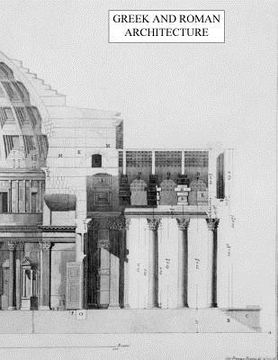Reseña del libro "Greek and Roman Architecture (en Inglés)"
During most of the history of architecture, architects had to be artists, engineers, and scholars. This three-volume series of books is about what architects needed to know to create the most important buildings in Western Architecture from 600 B. C.-A. D. 1943. This first volume is about Greek and Roman architecture and the architectural traditions that diverged from the Classic Tradition. The second volume is about the revival of classic architecture during the Renaissance. The third volume is about academic architecture since the Renaissance.Greek architecture was the first type that continued to be influential indefinitely and beyond the limits of its civilization. Most of the subsequent architecture of Europe was influenced by Greek architecture, but indirectly through Roman architecture. Rome owed a great debt to many aspects of Greek civilization including language, philosophy, and history as well as architecture and art. Roman art was essentially Greek art, but Roman architecture eventually became fundamentally different in the materials that were used and in its approach to design. The Greeks created the classical Orders and used them to plan and design the exterior of their buildings; the Roman developed the arch and concrete, which enabled spans and spaces of unprecedented size to be created. Greek architecture was more sculptural in its emphasis on exterior form and finish, and Roman architecture was more like engineering in its emphasis on spans and interior space. In general, Greek architecture was designed from the outside in, and Roman architecture from the inside out, but Greek design elements continued to embellish both the interiors and exteriors of Roman buildings.More specifically, the first volume of this series is about the development of Greek architecture, the influence of Greece on Rome, and the early influence of Rome on other architectural traditions outside the Roman Empire. The second volume is about the revival of Roman architecture and secular thought. The third volume is about the revival of all styles of architecture, their scholarly study by archaeologists and architects, and an increasingly eclectic used of design elements within the framework of the design principles of Classic Architecture.The classic tradition in architecture has determined the overall appearance of most buildings worldwide, and it has done so through the use of a versatile architectural vocabulary, a flexible set of rules, changing building types. Regardless of style, most buildings continue to be characterized by regularly proportioned and spaced design elements that were established through the use of the classical orders. This series of books discusses how a consistently high standard of excellence was achieved in design and construction over a period of 2,500 years. It includes the following periods of architecture: Greek, Roman, Renaissance, Baroque, Neoclassical, Greek Revival, Italianate, and Beaux Arts. Regardless of the style chosen, architects were in agreement about what constituted excellence. This book considers what all periods and styles have in common and what is most distinctive about each period, style, and major example. The primary emphasis is on how buildings were designed and constructed. Design processes, materials, and methods of construction are considered in detail. Everything an architect had to consider is discussed for each period and each building type. Every type of knowledge required to create buildings is considered. The ideas of the most influential architects are summarized, particularly those that were widely influential through the publications of Vitruvius, Palladio, Adam, Ledoux, and Schinkel.

